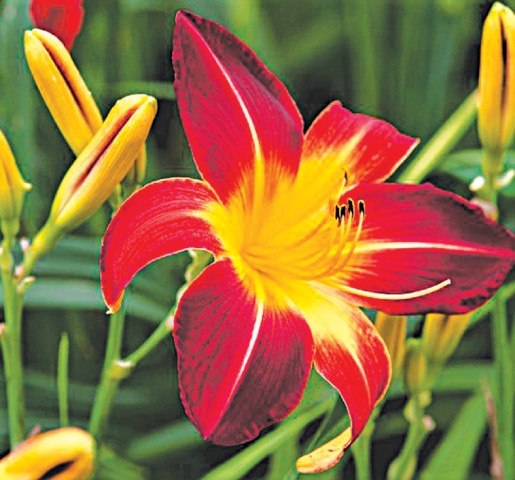
Close your eyes and picture dancing sunbeams, their essence distilled through stained glass windows, investing a cool, shady, very special place with wondrous light.
And then imagine a flower doing exactly this. Breathtakingly mesmerising, it is the only way to describe the sheer beauty of a clear lemon daylily, performing just one of the myriad tasks nature intended it to do.
Lemon daylily, brandishing the impressive botanical title Hemerocallis lilio-asphodelus syn. H. flava, owes its origin to China and has so much going for it that it surely tops the daylily class.
With its gorgeous lemony fragrant flowers, this exceptionally versatile daylily can be in bloom from mid-spring, on and off, right through until mid-autumn in our climate. Each flower lasts only a single day, but once established and in optimum growing conditions, the plants can be so prolific that they are literally smothered in bloom for weeks on end.
If you garden misses bold colour, some height, a small filler or a head-turner, there is a daylily waiting for you
And, if the impossible happens and you become fed up of looking at them, you can harvest flowers, preferably very early in the morning just as buds are unfurling. Stuff them with a small piece of mozzarella cheese, tie the petals closed with cotton thread, lightly fry them and enjoy a delicious treat.

Flower buds and petals can be made into fritters or used as an intriguing salad garnish. Young leaf shoots can be cooked like asparagus. In the unlikely event of wanting to dig up and dispose of the plants entirely, the fleshy roots can be boiled or baked, topped with grated cheese, a knob of butter and a sprinkling of parsley, and served up. They will never guess what they are eating!
This particular daylily, along with all other members of its family, flourishes in partial or dappled shade of trees and shrubs, at the base of north-facing walls, in an eastward facing location, where they greet the rising sun as it gilds them with gentle sunlight in the passing.
Daylilies generally achieve heights of 18-48 inches, depending on the exact strain. Tall-growing varieties are best grown directly in the ground, but smaller varieties are perfectly comfortable in suitably large clay pots or other containers with drainage holes in their base.
Daylilies do best in a reasonably well-draining soil that has had plenty of compost — preferably homemade and preferably organic — mixed in. Daylilies do a good job of mulching themselves, their strap-shaped leaves naturally dying back, falling over and forming a protective, nourishing layer of cooling goodness over their plump roots.
During these times of increasing shortages, watering is necessary during periods of hot, dry weather. Daylilies can be sustained with water recycled from household use, as long as it is 100 percent free of chemicals.
Some varieties multiply rapidly. To maintain daylilies at their floriferous best, the roots should be dug up, divided and then replanted from early winter through until very early spring.
Daylily flowers, particularly the light and bright colour ranges, gift a glorious dazzle to shady parts of the garden whilst the velvet lushness of darker ones — deep crimson, amethyst, ruby and old gold — paint a different palette.
The trumpet-shaped flowers, much loved by bumble bees, may sing their praises in either single or double form. Here are some recommendations to consider:
Lemon, yellow and gold

Hemerocallis Betty Woods — double yellow flowers, semi-evergreen, height 2ft.
Lemon daylily — semi-evergreen, height 3-4ft.
H. Bonanza — bright yellow flowers with deep red cents, semi-evergreen, height 2-3ft.
H. Cat’s cradle — sunshine yellow spider-like blooms, semi-evergreen, height 3ft.
H. Golden chimes — deep yellow flowers with brown on the outside, evergreen, height 2ft.
White and cream
H. Cream drop — perfumed creamy flowers with ruffles, semi-evergreen, height 2ft.
H. Gentle shepherd — ruffled, green-throated white flowers, semi-evergreen height 2ft.
H. Joan Senior — white, semi-evergreen, height 2ft.
Orange shades
H. Fulva — Tawny orange flowers, evergreen, height 3-4ft.
H. Burning daylight — Orangey-brown flowers, semi-evergreen, height 2-3ft.
H. Ruffled apricot — dark apricot, evergreen, height 2-3ft.
Reds
H. Cherry cheeks — bright red flowers, semi-evergreen, height 16-20inches.
H. Crimson pirate — bright crimson, evergreen, height 2-3ft.
H. Ed Murray — deep maroon, semi-evergreen, height 24-30inches.
Purples
H. Always afternoon — lavender-coloured blooms, semi-evergreen, height 2ft.
H. Summer purple — purple-red, evergreen, height 3ft.
H. Night bacon — deep burgundy trumpets, evergreen, height 2-3ft.
If you have problems sourcing the plants try tracking down seeds instead. Relatively easy to grow from autumn- or spring-sown seed, plants can flower from their second year. If you have obtained a packet or two of mixed daylily seeds, you will have quite a few lovely surprises in store, but do be patient.
Please continue sending your gardening queries to zahrahnasir@hotmail.com. Remember to include your location. The writer does not respond directly by email. Emails with attachments will not be opened
Published in Dawn, EOS, July 31st, 2022















































Dear visitor, the comments section is undergoing an overhaul and will return soon.